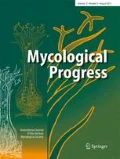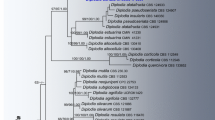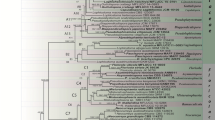Abstract
Lamprospora densireticulata sp. nov. is described and illustrated based on fresh collections from Austria, Croatia, Cyprus, France, Germany, Hungary and Spain. Its most important distinguishing characters are subglobose ascospores ornamented with a fine, irregular dense net and the infection on rhizoids of its host moss Aloina ambigua. Two other similar species differing mainly in their host mosses and ecology are also described in detail: these are L. carbonicola infecting Funaria hygrometrica occuring on soil and L. dictydiola growing on Tortula muralis on walls, stones or rocks. Phylogenetic analyses of ITS and LSU rDNA show that the studied collections of all three species form well-supported monophyletic clades exhibiting only very little polymorphism within the individual species. Comparative tables listing other morphologically similar species of Lamprospora and Octospora are provided.







Similar content being viewed by others
References
Benkert D (1987) Beiträge zur Taxonomie der Gattung Lamprospora (Pezizales). Z Mykol 53(2):195–271
Benkert D (1990) Zwei neue Arten der Gattung Lamprospora (Pezizales, Ascomycetes). Feddes Repert 101(11–12):631–637
Benkert D (1997) Beiträge zur Kenntnis bryophiler Pezizales-Arten. 5. Neue Arten der Gattung Octospora. In: Arbeitsgemeinschaft für Mykologie Ostwürttemberg (AMO) (ed) Beiträge zur Kenntnis der Pilze Mitteleuropas XI, Einhorn-Verlag, Schwäbisch Gmünd, pp 35–42
Benkert D (2001) Neotypisierung von Lamprospora miniata De Not. (Ascomycetes, Pezizales) und die Problematik des “Lamprospora miniata-Komplexes”. Micologia 2000:47–61
Benkert D (2007) Zur Kenntnis des Vorkommens bryophiler Pezizales (Ascomycota) in Südost-Europa. Mycol Monten X:7–21
Boudier E (1905–1910) Icones mycologicæ ou Iconographie des champignons de France. Paris, Paul Klincksieck, 4 vol.
Boudier E (1907) Histoire et classification des Discomycètes d'Europe. Paris, Paul Klincksieck
Dennis RWG, Itzerott H (1973) Octospora and Inermisia in Western Europe. Kew Bull 28(1):5–23
Döbbeler P (1980) Untersuchungen an moosparasitischen Pezizales aus der Verwandtschaft von Octospora. Nova Hedwigia 31:817–864
Doyle JJ, Doyle JL (1987) A rapid DNA isolation procedure for small quantities of fresh leaf tissue. Phytochem Bull 19:11–15
Eckstein J (2014) Lamprospora hispanica und Lamprospora tuberculatella—zwei bryoparasitische Discomyceten (Ascomycota, Pezizales) neu für Deutschland. Z Mykol 80(1):105–117
Egertová Z, Eckstein J, Sochor M, Vega M (2018) Lamprospora sylvatica (Pyronemataceae), a new bryophilous ascomycete on Dicranum montanum. Phytotaxa 357(1):17–29. https://doi.org/10.11646/phytotaxa.357.1.2
Gardes M, Bruns TD (1993) ITS primers with enhanced specificity for Basidiomycetes—application to the identification of mycorrhizae and rusts. Mol Ecol 2(2):113–118. https://doi.org/10.1111/j.1365-294X.1993.tb00005.x
Guindon S, Dufayard JF, Lefort V, Anisimova M, Hordijk W, Gascuel O (2010) New algorithms and methods to estimate maximum-likelihood phylogenies: assessing the performance of PhyML 3.0. Syst Biol 59(3):307–321. https://doi.org/10.1093/sysbio/syq010
Hansen K, Perry BA, Dranginis AW, Pfister DH (2013) A phylogeny of the highly diverse cup-fungus family Pyronemataceae (Pezizomycetes, Ascomycota) clarifies relationships and evolution of selected life history traits. Mol Phylogenet Evol 67(2):311–335. https://doi.org/10.1016/j.ympev.2013.01.014
Itzerott H, Thate R (1974) A new species of Octospora (Humariaceae). Kew Bull 29(3):506
Katoh K, Rozewicki J, Yamada KD (2017) MAFFT online service: multiple sequence alignment, interactive sequence choice and visualization. Brief Bioinform, bbx108. https://doi.org/10.1093/bib/bbx108
Lefort V, Longueville JE, Gascuel O (2017) SMS: smart model selection in PhyML. Mol Biol Evol 34(9):2422–2424. https://doi.org/10.1093/molbev/msx149
Martínez-Gil R, Caballero A (2015) Ascomicetos raros o interesantes de La Rioja, España (I). Bol Micol FAMCAL 10:73–88
O'Donnell K (1993) Fusarium and its near relatives. In: Reynolds DR, Taylor JW (eds) The fungal holomorph: mitotic, meiotic and pleomorphic speciation in fungal systematics. CAB International, Wallingford, pp 225–233
Perry BA, Hansen K, Pfister DH (2007) A phylogenetic overview of the family Pyronemataceae (Ascomycota, Pezizales). Mycol Res 3:549–571. https://doi.org/10.1016/j.mycres.2007.03.014
Ronquist F, Huelsenbeck JP (2003) MrBayes 3: Bayesian phylogenetic inference under mixed models. Bioinformatics 19(12):1572–1574
Stenroos S, Laukka T, Huhtinen S, Döbbeler P, Myllys L, Syrjänen K, Hyvönen J (2010) Multiple origins of symbioses between ascomycetes and bryophytes suggested by a five-gene phylogeny. Cladistics 26(3):281–300. https://doi.org/10.1111/j.1096-0031.2009.00284.x
Vega M, Eckstein J, Van der Kolk HJ (2016) Lamprospora verrucispora sp. nov. (Pezizales). Ascomycete.org 8(4):163–171. https://doi.org/10.25664/art-0184
Vega M, Eckstein J, Friebes G, Tena Lahoz R, Gube M (2017) Lamprospora pseudoarvensis sp. nov. (Pezizales)—a lookalike tracked down. Ascomycete.org 9(5):139–148. https://doi.org/10.25664/art-0207
Vilgalys R, Hester M (1990) Rapid genetic identification and mapping of enzymatically amplified ribosomal DNA from several Cryptococcus species. J Bacteriol 172(8):4238–4246
White TJ, Bruns T, Lee S, Taylor J (1990) Amplification and direct sequencing of fungal ribosomal RNA genes for phylogenetics. In: Innis MA, Gelfand DH, Sninsky JJ, White TJ (eds) PCR protocols: a guide to methods and applications. Academic Press, New York, pp 315–322. https://doi.org/10.1016/B978-0-12-372180-8.50042-1
Acknowledgements
For information, documentation, exchange, support and/or sending samples, we would like to thank Torsten Richter (Germany), Beñat Jeannerot, Gilbert Moyne and Nicolas Van Vooren (France), Enrique Rubio (Spain) and Csaba Németh (Hungary). We are grateful to Michal Sochor (Czech Republic) for help with sequencing a part of the vouchers. Thanks go to Carol Hobart (UK) for revising the manuscript language-wise. LJ was supported by Institutional Support for Science and Research of the Ministry of Education, Youth and Sports of the Czech Republic, ZS by an internal grant from Palacký University (IGA_PrF_2019_004).
Author information
Authors and Affiliations
Corresponding author
Ethics declarations
Conflict of interest
The authors declare they have no conflict of interest.
Additional information
Editorial Responsibility: Roland Kirschner
Publisher’s note
Springer Nature remains neutral with regard to jurisdictional claims in published maps and institutional affiliations.
Rights and permissions
About this article
Cite this article
Vega, M., Janošík, L., Sochorová, Z. et al. Lamprospora densireticulata sp. nov., L. dictydiola and L. carbonicola (Pyronemataceae, Pezizales)—three very similar species from very different hosts and habitats. Mycol Progress 18, 1013–1026 (2019). https://doi.org/10.1007/s11557-019-01505-2
Received:
Revised:
Accepted:
Published:
Issue Date:
DOI: https://doi.org/10.1007/s11557-019-01505-2




